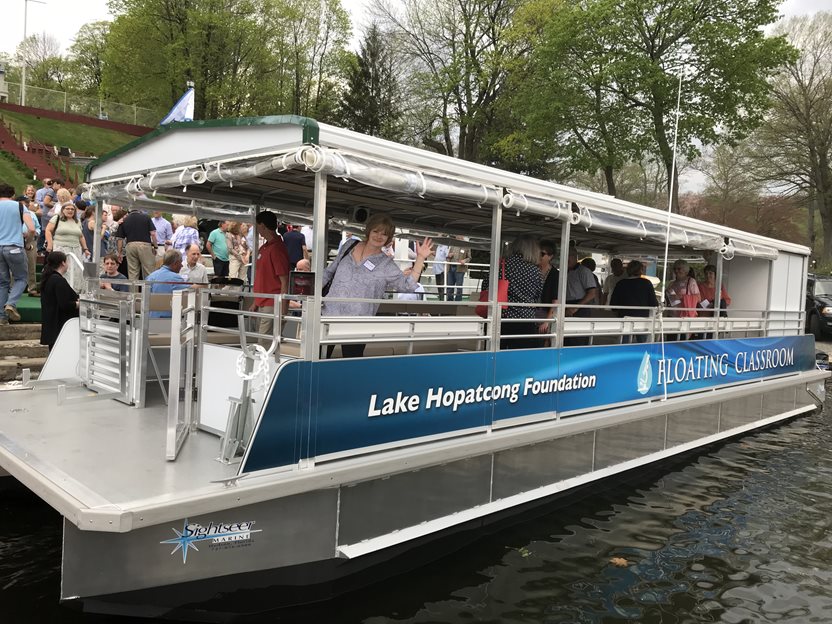
Situated along an idyllic shoreline dotted by houses, boats, and restaurants, New Jersey's Lake Hopatcong runs 9 miles long, lending it notoriety as the largest freshwater lake in the state. Hidden beneath the placid water, at varying depths of up to almost sixty feet, is a surprisingly complex and delicate ecosystem that requires constant study and maintenance. Protecting this fragile environment is the main mission of the Lake Hopatcong Foundation, founded in 2012 with the mission to "improve Lake Hopatcong for all, now and in the years to come.” While the Foundation has several initiatives to accomplish this, the core of their mission is dedicated to protecting and improving the lake's water quality. In order to do this, a fundamental understanding of how to accurately record and analyze data like pH, dissolved oxygen, and temperature is key.
In an effort to better address this understanding, now and for the future, the LHF instituted the "Study Hull", a 40-foot pontoon boat "floating classroom" inspired by the highly successful, award-winning floating classroom offered by the Lake George Association. Devoted to providing an interactive, hands-on education experience, the "Study Hull" gives students and the public the opportunity to learn about the importance of improving water quality and protecting the lake for future generations by focusing on water quality, lake ecology, the importance of aquatic plants, invasive aquatic species prevention, and watershed impacts on the lake. “We at the Lake Hopatcong Foundation spend a lot of our time working to protect the lake environment,” says LHF president Jessica K. Murphy. “But the best thing we can do for the future of Lake Hopatcong is educate the next generation and the public about how to take care of it. And what better way to conduct those lessons than on the lake itself?”
.aspx)
After several in-depth research meetings with other floating classrooms like it, LHF's "Study Hull" was able to set sail in May of 2018. In its first three months, the boat has already educated more than 800 local fourth- graders, and has built an impressive reputation across the northern New Jersey region, with school districts near and far reaching out to incorporate the floating classroom into their own curriculum. "Study Hull" spends its days crawling up and down the lake, teaching students and adults alike the tenets of water quality analysis and its importance by testing water clarity, viewing water samples, and measuring the lake's dissolved oxygen, temperature, and pH levels.
pH levels in particular are important to the overall health of the lake, since most plant and animal species thrive in an aquatic environment with pH levels of between 7.0 and 9.0. If the water is too acidic (5.0 or below) or too basic (9.0 or above), many aquatic species are unable to survive. The ability to measure these levels allows conservationists the opportunity to not only maintain the environment, but also the potential to predict which animal species will live in the lake.
.aspx?width=103&height=138)
With the use of the OHAUS ST20 Pen Meters, the "Study Hull" has been able to easily record pH and temperature levels at different water depths, offering students the opportunity to determine patterns and trends seen in the spring and summer months. The meter's simple operation has proved beneficial for young children who are not accustomed to operating measurement devices, allowing their instructors to spend more time on the importance of the measurements, as opposed to training them on the equipment. "We are quite satisfied with the ST20 pen meter. As we work out the proceedings of our own program, the meter is one of the easier experiments that we are able to run," says Program Director Donna Macalle-Holly, adding that the ST20 Pen Meter "is just a very easy instrument to use and to read. This becomes a very important feature when working with young children trying to understand a new concept in a limited amount of time."
Use of the OHAUS ST20 pen meters has enabled the "Study Hull" to run experiments that, previously, were not possible. Macalle-Holly states that the addition of the ST20 pen meters "has allowed us to incorporate more specific information regarding the health of our lake, as well as help turn our students into the young scientists that they are. Children are very excited to become involved in a very hands-on manner and they are now able to do so."
.aspx)
Of the many accomplishments achieved in the infancy of the Lake Hopatcong Foundation's "Study Hull", the most important is arguably the excitement and engagement it is able to inspire in the young students who partake in its lessons. "I think I might have had one of the best trips ever!" says a local fourth grader, while another asserts that "…My favorite part was when we went on the Floating Classroom because we got to learn about things like the pH level and temperature of the water.” To be able to teach future scientists not only the storied history behind the lake, but also how to analyze and understand the many pieces that water quality holds together, is easily the most effective way to maintain its future health and integrity.
Learn more about OHAUS
Starter Series Pen Meters